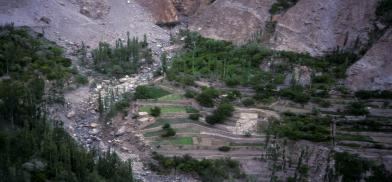Now climate change hits farmers in mountainous areas of Pakistan
This year, an early and hotter start to the summer has forced a change in the crop cycle in Gilgit-Baltistan, high up in the Hindu Kush Himalayas

Since March, major cities in Pakistan have experienced unseasonable and extremely high temperatures. However, farmers in the mountainous areas of the Upper Indus Basin in the Hindu Kush Himalayas have also been affected.
Last winter there was heavy rain and snowfall in the mountainous northern region of Gilgit-Baltistan. Despite this, Ashraf Khan, a farmer in the Yasin Valley in Gilgit-Baltistan’s Ghizer district, said his fields dried up in March and he had to sow his summer wheat earlier than in previous years.
The Pakistan Meteorological Department’s (PMD) weather station at Gupis in Ghizer has recorded an upward trend in maximum, minimum and average temperatures in March and April over the past decade, with 2022 having the highest temperatures in the past 10 years.
“Usually, we sow our wheat and potato crops between 15 and 25 April. This year, we had to start sowing towards the end of March due to dryness in the soil, although we had record snowfall during winter and we were thinking to sow crops by the end of April. But the snow melted abruptly due to the unusually high temperatures in the month of March,” said Khan, talking with The Third Pole in his home about 200 kilometres from Gilgit, the region’s capital.
The PMD measured 30 metres of snowfall in the district in January, and six in April. The early melt is leading to dry soil and a shortage of water for irrigation.
“The concern is not only the dryness in the soil. The snow started melting rapidly even at a high altitude much earlier than expected,” Khan said.
Farmers started irrigating their crops in early May this year, almost a month earlier than usual, as they were afraid the meltwater would flow down the slopes if they waited. With their crops planted on terraces on steep slopes, there is little farmers in the region can do to harvest and store the meltwater.
Early flowering in orchards of Gilgit-Baltistan
Joher Ali, a farmer from Thoi, a village in Ghizer that is famous for its orchards, said that temperatures since March have been as high as the beginning of May. “This forced us to start farming activities earlier. In our village, the flowering of almonds, apricots, apples and other [crops] started 15 to 20 days earlier than usual. We had to sow our crops early. There have been hot years before, but this year the change is much more marked.”
Orchard owners are worried because rising temperatures are bringing more pests. Zareen Bibi, another farmer from Thoi, said apricots, apples and peaches have been infected by more pests in the past five years, and she is losing more than half her harvest. “Fruits are turning red before they ripen, and small insects appear inside the fruits, causing them to rot.”
Bibi said she earned 180,000 Pakistani rupees (about USD 870) from selling her fruit in 2015, but her earnings had declined to PKR 100,000 (USD 480) in 2021. “The taste and shape of the fruit have also changed noticeably for the worse, which means less value in the market.”
Experts and farmers in agreement
Sher Ahmed, regional head of the Pakistan Agricultural Research Council (PARC) in Gilgit-Baltistan, told The Third Pole that the region’s climate has changed visibly, with serious implications for farming. He said spring used to start in mid-March, but has started by the end of February in recent years, shortening the winter.
Ahmed confirmed Bibi’s experience, saying “the rise in temperature has also caused diseases in crops and fruit, and insects and flies often infect them”. However, at the same time, he pointed out that prolonged and comparatively hotter summers give crops at higher altitudes more time to mature.
“The temperature and climate have definitely changed over the past one-and-a-half decades, which has both positive and negative effects on mountain communities,” agreed Muhammad Ayub, senior scientific officer at the PARC centre in Skardu, a city in Gilgit-Baltistan.
“This extreme temperature causes wheat crops to mature suddenly in July, with some adverse implications [for the size and quality of the harvest],” said Ayub. “We now advise farmers in some areas to sow wheat and onion in late autumn, rather than early spring.” Ayub said this gave the crops time to grow “gradually”, which improved their quality.
The International Centre for Integrated Mountain Development (ICIMOD), WWF Pakistan and the Aga Khan Rural Support Programme carried out a joint study in 2021 on local perceptions of climate change among residents of two places in Gilgit-Baltistan and one in the northwestern province of Khyber Pakhtunkhwa. Residents told researchers they had seen a decline in rainfall and snowfall in the past 10 years, hotter summers, winters that were not as cold as before, and more “erratic events”.
Climate change may not be the only culprit
Furrukh Bashir, deputy director of the PMD in Gilgit-Baltistan, agreed that temperatures have been comparatively higher so far this year, but cautioned that “it is a regular feature that, some years, the temperature rises and some years it turns low. While the temperature has definitely changed towards being higher, attributing it only to climate change is unrealistic, and we need more focused research and analysis to draw a conclusion.
“While extreme events are more frequent, climate change is not the sole responsible factor. Other factors, like a change in lifestyles, are also behind this.”
Bashir held the use of concrete and tin, rather than traditional stone and thatch, in construction responsible as well. Stone and thatch are better heat insulators, keeping buildings cooler in summers and warmer in winters.
(The author is an environmental journalist in Pakistan. Views are personal. By special arrangement with The Third Pole)










Post a Comment